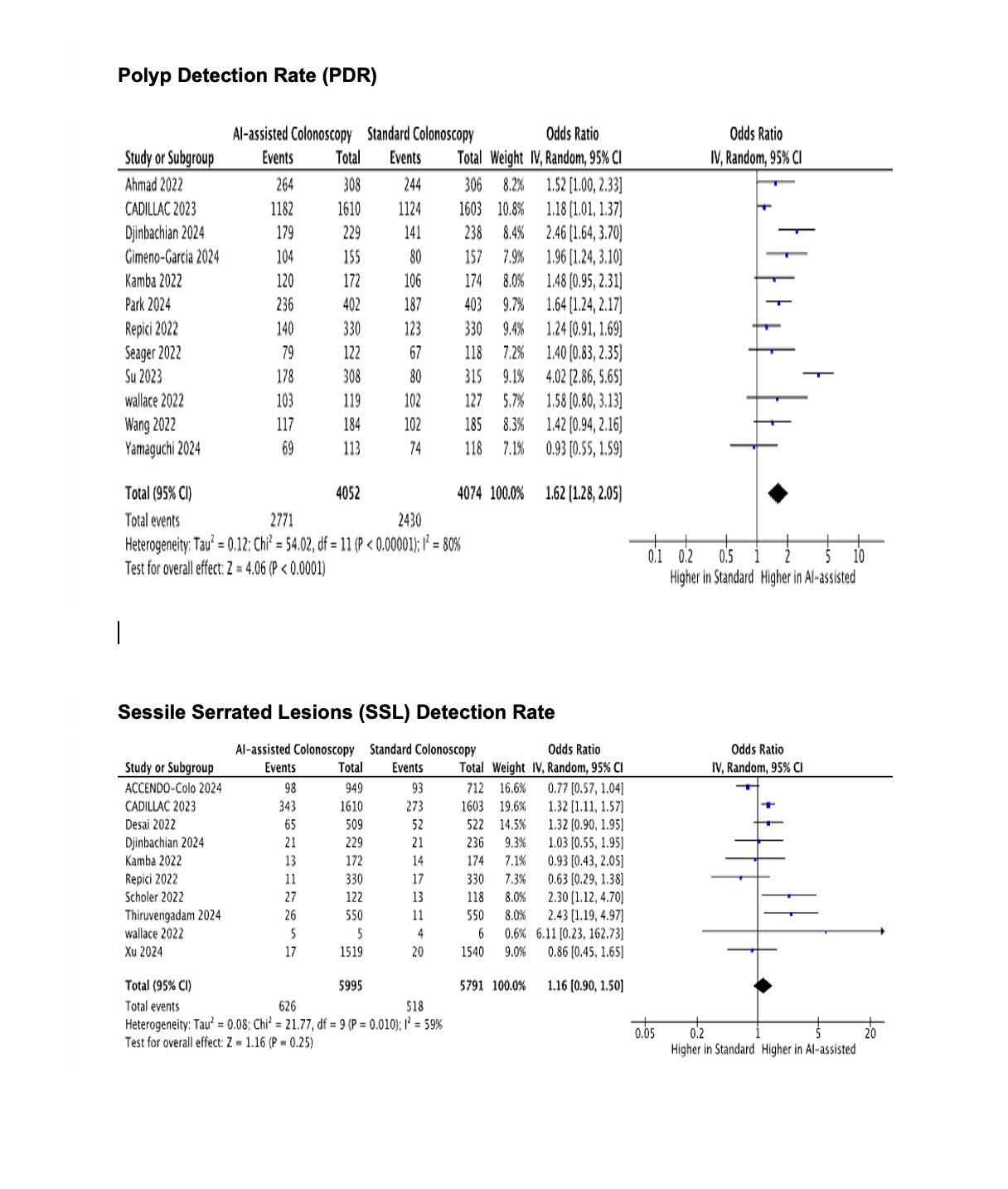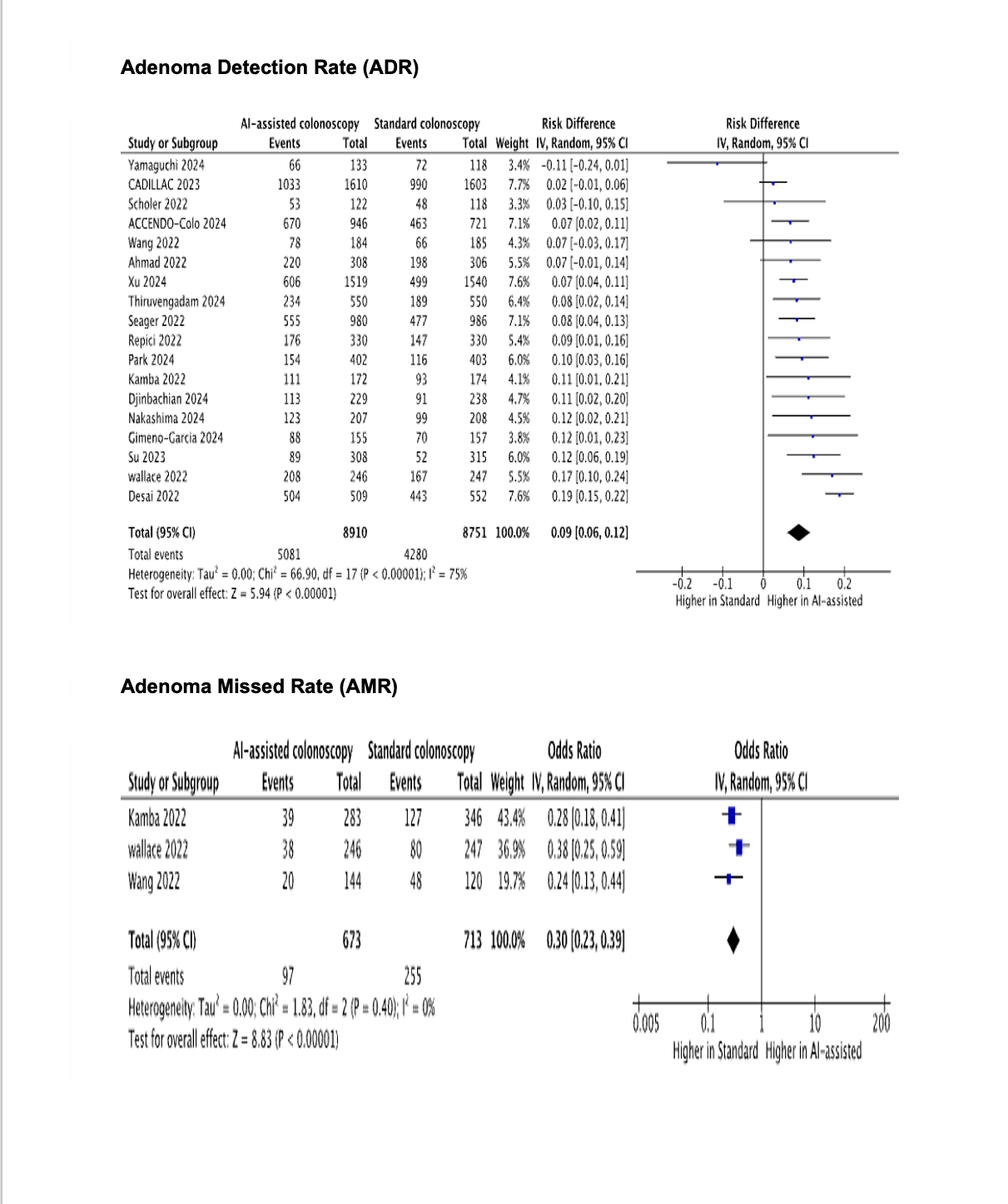Sunday Poster Session
Category: Colorectal Cancer Prevention
P0525 - Artificial Intelligence-Driven Colonoscopy for Early Detection of Colorectal Cancer: A Meta-Analysis and Systematic Review of RCTs
Sunday, October 26, 2025
3:30 PM - 7:00 PM PDT
Location: Exhibit Hall

Bolaji O. Ayinde, MD
Northeast Georgia Medical Center
Gainesville, GA
Presenting Author(s)
Bolaji O. Ayinde, MD1, Meyof Sabeth Mbiih Toukam, 2, Chizoba J. Aneke, 3, Joseph B. Awe, 4
1Northeast Georgia Medical Center, Gainesville, GA; 2All Saints University School of Medicine, Upper Malboro, MD; 3All Saints University,School of Medicine, Roseau, Saint George, Dominica; 4All Saints University, Goodwill, Saint John, Dominica
Introduction: Colorectal cancer ranks among the most prevalent cancers worldwide, hence an effective screening and early identification ought to be explored for prevention. Colonoscopy, crucial for the detection of precancerous lesions, utilizes the adenoma detection rate (ADR) as a primary quality measure. A higher ADR is linked to a decreased risk of cancer after colonoscopy. Nevertheless, traditional colonoscopy faces difficulties such as variable detection rates due to the skill of the endoscopist, challenges in recognizing sessile serrated lesions, and cognitive fatigue, which can lead to missed adenomas. AI-assisted colonoscopy, which incorporates computer-aided detection (CADe) systems like GI Genius and Eagle-Eye, facilitates real-time lesion identification, thereby improving ADR, polyp detection rate (PDR), and detection reliability.
Methods: Following the PRISMA guidelines, we included 18 RCTs that evaluated AI-assisted colonoscopy with CADe systems versus traditional methods. A search was performed using MEDLINE and Cochrane CENTRAL from 2020 to 2025. Data on ADR, AMR, PDR, SSL, and adverse events were retrieved.
Results: In 18 trials, the use of AI-assisted colonoscopy led to a notable increase in adenoma detection rates (8,910 AI compared to 8,751 standard), yielding a pooled risk difference of 0.09 (95% CI [0.06, 0.12], I²=75%, p< 0.00001). The AMR exhibited a significant reduction across five trials (RR=0.30, 95% CI [0.23, 0.39], I²=0%, p< 0.00001). Eleven studies indicated an increased polyp detection rate (PDR) (RR=1.62, 95% CI [1.06, 1.18], I²=55%, p< 0.00001). However, the detection of sessile serrated lesions (SSL) did not demonstrate any significant improvement (OR=1.16, 95% CI [0.90, 1.50], I²=59%, p=0.010). Safety is corroborated by similar adverse events (RR=1.10, 95% CI [0.61, 1.97], I²=19%, p=0.75).
Discussion: This meta-analysis suggests that AI-assisted colonoscopy enhances ADR and reduces AMR compared to standard colonoscopy, with no significant changes in adverse events. These findings highlight AI's proven ability to improve the colorectal cancer screening procedure by increasing diagnostic accuracy. The ADR pooled risk difference magnitude of 0.06 in AI-assisted colonoscopy (95% CI 0.03, 0.09) suggests AI's efficiency in detecting adenomas, which play an important role in the progression of CRC. The study found high heterogeneity (I² = 78%), possibly due to differences in AI algorithms or patient demographics.

Figure: Adenoma Detection Rate (ADR) and Adenoma Missed Rate (AMR)

Figure: Polyps Detection Rate (PDR) and Sessile Serrated Lesions (SSL) Detection Rate
Disclosures:
Bolaji Ayinde indicated no relevant financial relationships.
Meyof Sabeth Mbiih Toukam indicated no relevant financial relationships.
Chizoba Aneke indicated no relevant financial relationships.
Joseph Awe indicated no relevant financial relationships.
Bolaji O. Ayinde, MD1, Meyof Sabeth Mbiih Toukam, 2, Chizoba J. Aneke, 3, Joseph B. Awe, 4. P0525 - Artificial Intelligence-Driven Colonoscopy for Early Detection of Colorectal Cancer: A Meta-Analysis and Systematic Review of RCTs, ACG 2025 Annual Scientific Meeting Abstracts. Phoenix, AZ: American College of Gastroenterology.
1Northeast Georgia Medical Center, Gainesville, GA; 2All Saints University School of Medicine, Upper Malboro, MD; 3All Saints University,School of Medicine, Roseau, Saint George, Dominica; 4All Saints University, Goodwill, Saint John, Dominica
Introduction: Colorectal cancer ranks among the most prevalent cancers worldwide, hence an effective screening and early identification ought to be explored for prevention. Colonoscopy, crucial for the detection of precancerous lesions, utilizes the adenoma detection rate (ADR) as a primary quality measure. A higher ADR is linked to a decreased risk of cancer after colonoscopy. Nevertheless, traditional colonoscopy faces difficulties such as variable detection rates due to the skill of the endoscopist, challenges in recognizing sessile serrated lesions, and cognitive fatigue, which can lead to missed adenomas. AI-assisted colonoscopy, which incorporates computer-aided detection (CADe) systems like GI Genius and Eagle-Eye, facilitates real-time lesion identification, thereby improving ADR, polyp detection rate (PDR), and detection reliability.
Methods: Following the PRISMA guidelines, we included 18 RCTs that evaluated AI-assisted colonoscopy with CADe systems versus traditional methods. A search was performed using MEDLINE and Cochrane CENTRAL from 2020 to 2025. Data on ADR, AMR, PDR, SSL, and adverse events were retrieved.
Results: In 18 trials, the use of AI-assisted colonoscopy led to a notable increase in adenoma detection rates (8,910 AI compared to 8,751 standard), yielding a pooled risk difference of 0.09 (95% CI [0.06, 0.12], I²=75%, p< 0.00001). The AMR exhibited a significant reduction across five trials (RR=0.30, 95% CI [0.23, 0.39], I²=0%, p< 0.00001). Eleven studies indicated an increased polyp detection rate (PDR) (RR=1.62, 95% CI [1.06, 1.18], I²=55%, p< 0.00001). However, the detection of sessile serrated lesions (SSL) did not demonstrate any significant improvement (OR=1.16, 95% CI [0.90, 1.50], I²=59%, p=0.010). Safety is corroborated by similar adverse events (RR=1.10, 95% CI [0.61, 1.97], I²=19%, p=0.75).
Discussion: This meta-analysis suggests that AI-assisted colonoscopy enhances ADR and reduces AMR compared to standard colonoscopy, with no significant changes in adverse events. These findings highlight AI's proven ability to improve the colorectal cancer screening procedure by increasing diagnostic accuracy. The ADR pooled risk difference magnitude of 0.06 in AI-assisted colonoscopy (95% CI 0.03, 0.09) suggests AI's efficiency in detecting adenomas, which play an important role in the progression of CRC. The study found high heterogeneity (I² = 78%), possibly due to differences in AI algorithms or patient demographics.

Figure: Adenoma Detection Rate (ADR) and Adenoma Missed Rate (AMR)

Figure: Polyps Detection Rate (PDR) and Sessile Serrated Lesions (SSL) Detection Rate
Disclosures:
Bolaji Ayinde indicated no relevant financial relationships.
Meyof Sabeth Mbiih Toukam indicated no relevant financial relationships.
Chizoba Aneke indicated no relevant financial relationships.
Joseph Awe indicated no relevant financial relationships.
Bolaji O. Ayinde, MD1, Meyof Sabeth Mbiih Toukam, 2, Chizoba J. Aneke, 3, Joseph B. Awe, 4. P0525 - Artificial Intelligence-Driven Colonoscopy for Early Detection of Colorectal Cancer: A Meta-Analysis and Systematic Review of RCTs, ACG 2025 Annual Scientific Meeting Abstracts. Phoenix, AZ: American College of Gastroenterology.
